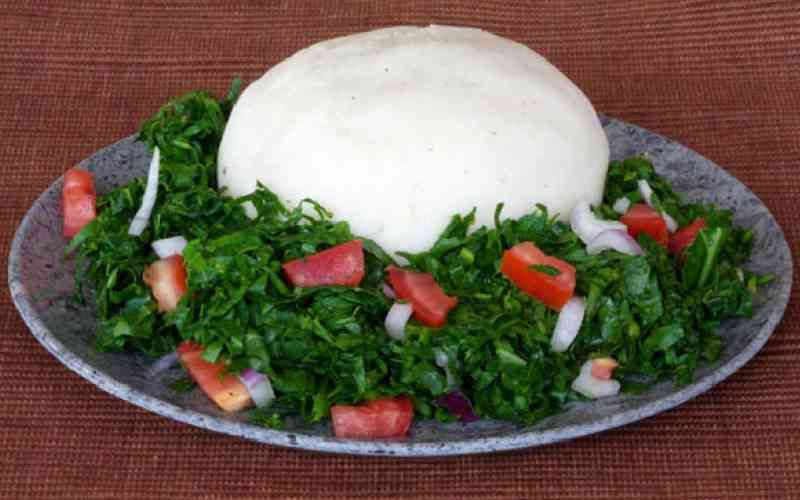
Have you ever eaten but still felt weak or tired? That’s because while certain foods fill the stomach, they do not provide the body with the nutrients it truly needs. This is where fortification comes in.
You have probably seen the logo “Fortified” on everyday foods, such as flour, salt, and cooking products. But have you ever stopped to wonder what it really means?
According to Prof Douglas Miano, a Kenyan scientist and virologist, fortification is the process of increasing the nutrient content of a food. “It’s actually the addition of nutrients to a particular product so that it becomes better,” says Prof. Miano.
In Kenya, fortification of maize flour, wheat flour, edible oils, and salt is mandatory to combat micronutrient deficiencies.
Fortification helps tackle common deficiencies, such as iron (which causes anaemia), iodine (which leads to goitre), vitamin A, and folic acid.
Mother died of goitre complications
Goitre is an enlargement of the thyroid gland, often caused by a lack of dietary iodine. Women are more susceptible to goitre and other thyroid complications. Fortification can prevent goitre by adding iodine to salt, ensuring adequate iodine intake, which is essential for thyroid hormone production.
Rita grew up seeing her mother with a swelling on her neck, which she later learnt was called goitre.
“It was never a big deal, because she went for check-ups and was advised to have surgery only for cosmetic reasons, as the goitre posed no danger,” she recalls.
Her mother feared surgery and the possible complications, so she chose not to have the operation. The swelling didn’t grow much, but was sometimes painful to the touch.
However, things changed a few years later.
“In 2016, she became really ill. They said the goitre had spread inwards. We thought it was pneumonia because she had severe chest pain. It was a misdiagnosis. In hindsight, the pain we thought was pneumonia had been there for years. I remember she had complained of the same in 2008,” says Rita.
Tragically, Rita’s mother died in early 2017.
Her case is just one of many. Besides iodine deficiency, malnutrition remains a major issue, characterised by a triple burden of undernutrition, micronutrient deficiencies, and overweight or obesity.
Salt iodisation
Following high rates of goitre between 1962 and 1964, voluntary salt iodisation began in 1972. By 1978, salt iodisation became mandatory.
According to the Ministry of Health, goitre prevalence reduced from 35 per cent to six per cent by 1999, after salt iodisation became routine in salt processing industries.
Abubakar Abdallah, Operations Manager at Pembe Flour Mills, explains that fortification is done at the blending stage, after the flour has been sifted and milled, but before packaging. The equipment used is a micro dozer.
Eng John Odada, Head of Operations at Mvita Oils, says their fortification process involves adding vitamin A palmitate, measured in milligrams per kilogramme, in accordance with Kenya Bureau of Standards (KEBS) levels. “There is a minimum level and a range within which we need to carry out fortification — from 20 milligrams to 40 milligrams per kilogramme of oil or fat,” he says.
Eng. Odada adds that fortification is monitored at every stage of production, done batch-wise. “We consistently monitor using independent laboratories, in addition to our internal lab. This helps ensure the batches going through fortification meet required levels. We also submit products for external analysis to confirm we are within range,” he says.
On challenges, Eng. Odada explains that sometimes their fortified products test below requirements. “When fortifying, we use premixes sourced from suppliers. To avoid any uncertainties, we work with companies, such as Technoserve, which help us by sending our premixes to independent labs, especially in America, to verify quality. Since premixes are not manufactured in Kenya, we rely on the Certificates of Analysis (COA) provided by these suppliers,” he says.
Nutrition situation in Kenya
Rizwan YusfAli, Programmes Director for Millers for Nutrition at Technoserve, notes that while Kenya’s nutrition situation is improving, significant underlying challenges remain. “Look at iron deficiency, vitamin A deficiency, zinc, and some folate deficiencies. These are still quite high compared to countries that have done better than us. Therefore, we need a concerted effort with multiple interventions, not only food fortification, to address and accelerate progress,” says Rizwan.
He adds that they work closely with communities, who do not want handouts, but rather fair and easy access to safe, nutritious foods they can use.
“We’ve learned that nutrition interventions only work if they consider the realities of people’s lives, what they can afford and what they cook at home. For nutrition efforts to be effective, they must factor in how people actually consume food,” says Rizwan.
Since fortification of certain staple foods is mandatory, these foods must be certified by the Kenya Bureau of Standards (KEBS).KEBS sets and enforces national standards for fortified foods, particularly maize flour, wheat flour, edible oils, and salt.
According to KEBS, any manufacturer applying for the Fortification logo must have acquired the S-Mark in line with KEBS procedures.
Fight micro-nutrient deficiencies
The Ministry of Health implemented a five-year National Food Fortification Strategic Plan (NFFSP) from 2018 to 2022, as a key tool in the fight against micronutrient deficiencies.
The plan provided a strategic framework to improve the production and consumption of fortified foods to meet national nutritional needs. It was designed to guide the Ministry of Health and facilitate increased access to quality fortified foods for all Kenyans, addressing nutritional requirements for good health.
According to the Global Alliance for Improved Nutrition (GAIN), micronutrient deficiencies are widespread globally. Recent studies reveal that one in two children and two in three women are deficient in at least one essential micronutrient.
Fortifying staple foods with micronutrients is a cost-effective and safe intervention proven to prevent deficiencies and their associated outcomes.
As beneficial as food fortification is for health, there are some downsides. Overconsumption of certain nutrients can cause health problems. The cost of fortification equipment and imported premixes, can also increase the price of fortified foods.
 The Standard Group Plc is a multi-media organization with investments in media
platforms spanning newspaper print
operations, television, radio broadcasting, digital and online services. The
Standard Group is recognized as a
leading multi-media house in Kenya with a key influence in matters of national
and international interest.
The Standard Group Plc is a multi-media organization with investments in media
platforms spanning newspaper print
operations, television, radio broadcasting, digital and online services. The
Standard Group is recognized as a
leading multi-media house in Kenya with a key influence in matters of national
and international interest.











